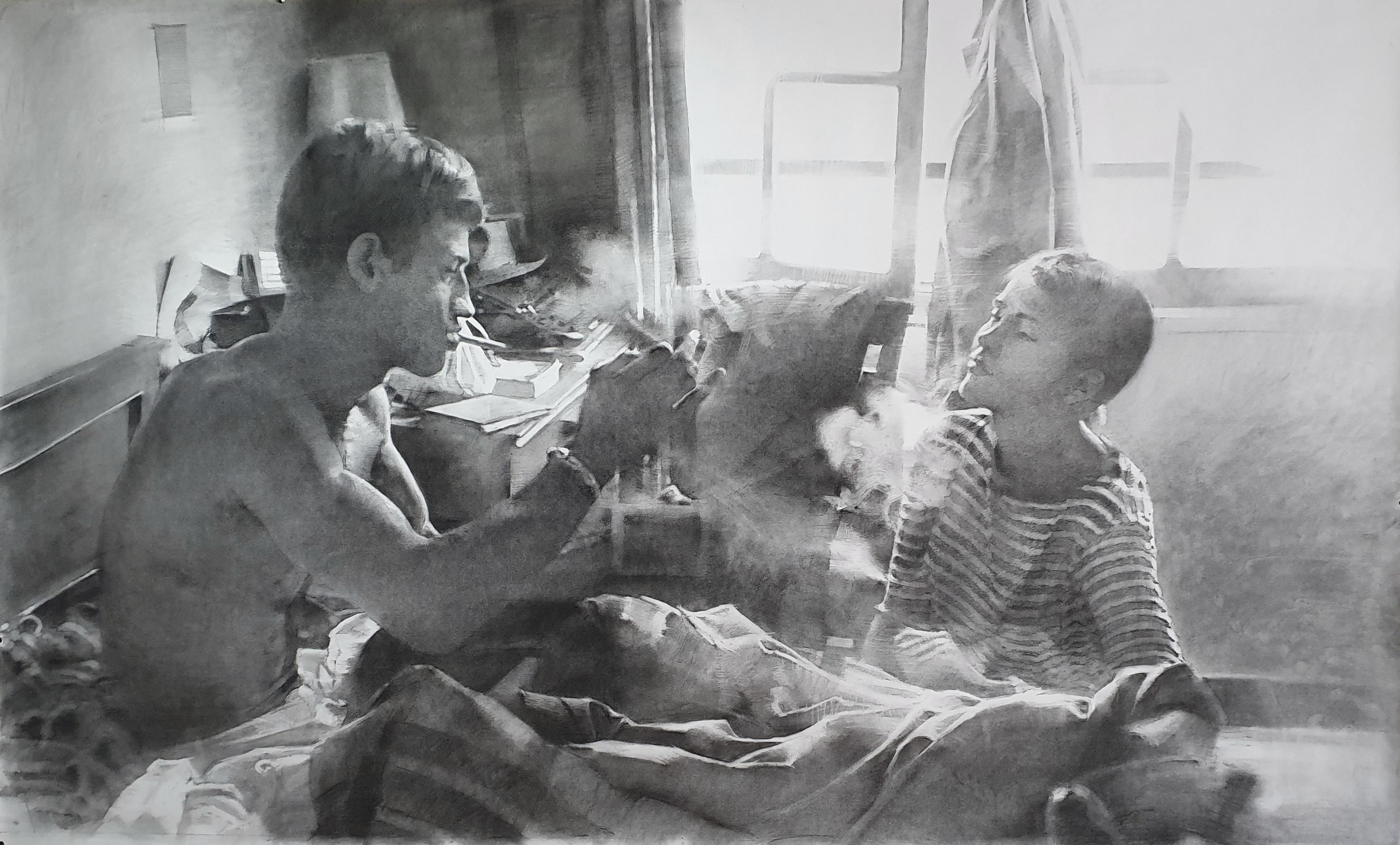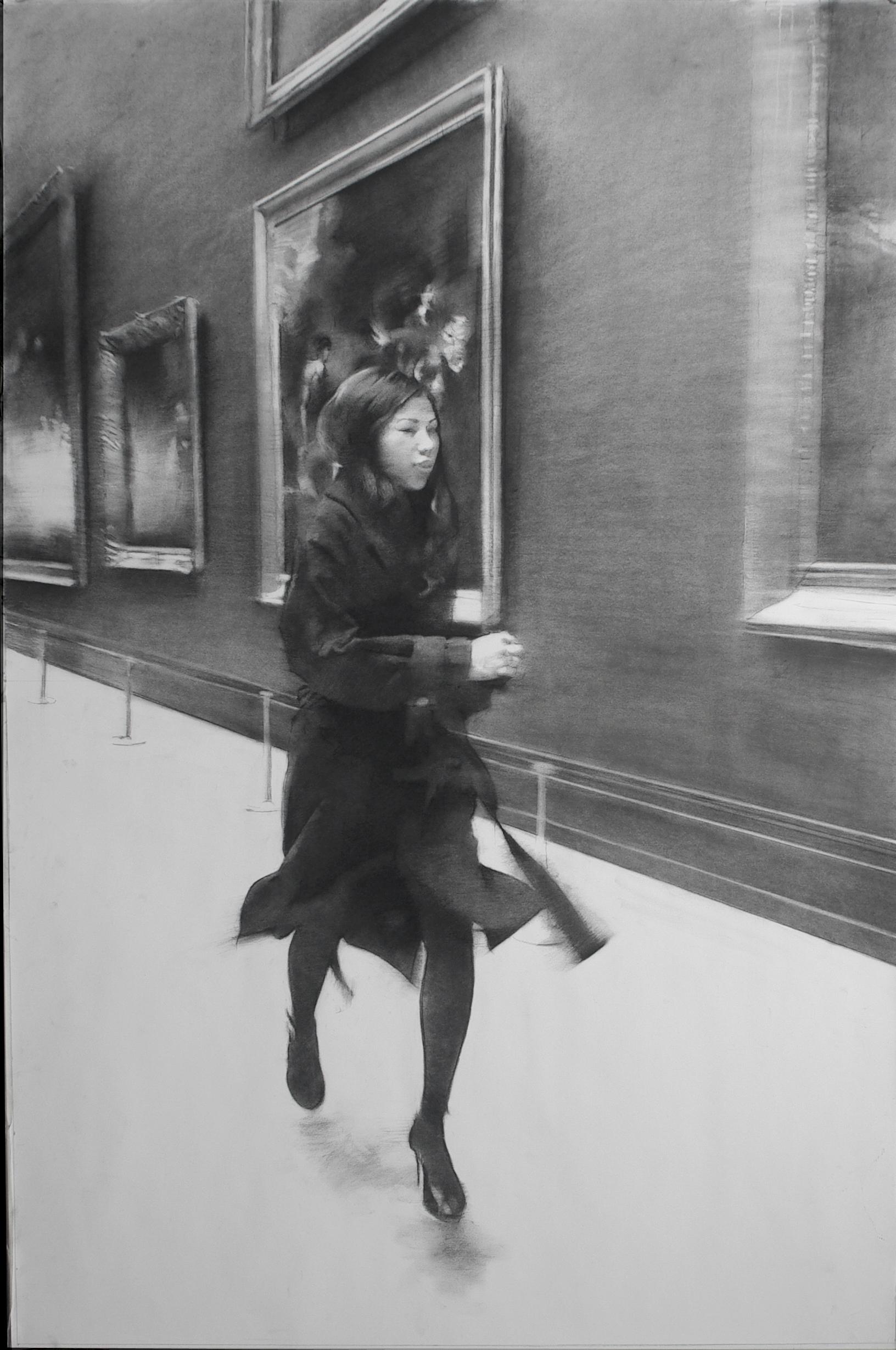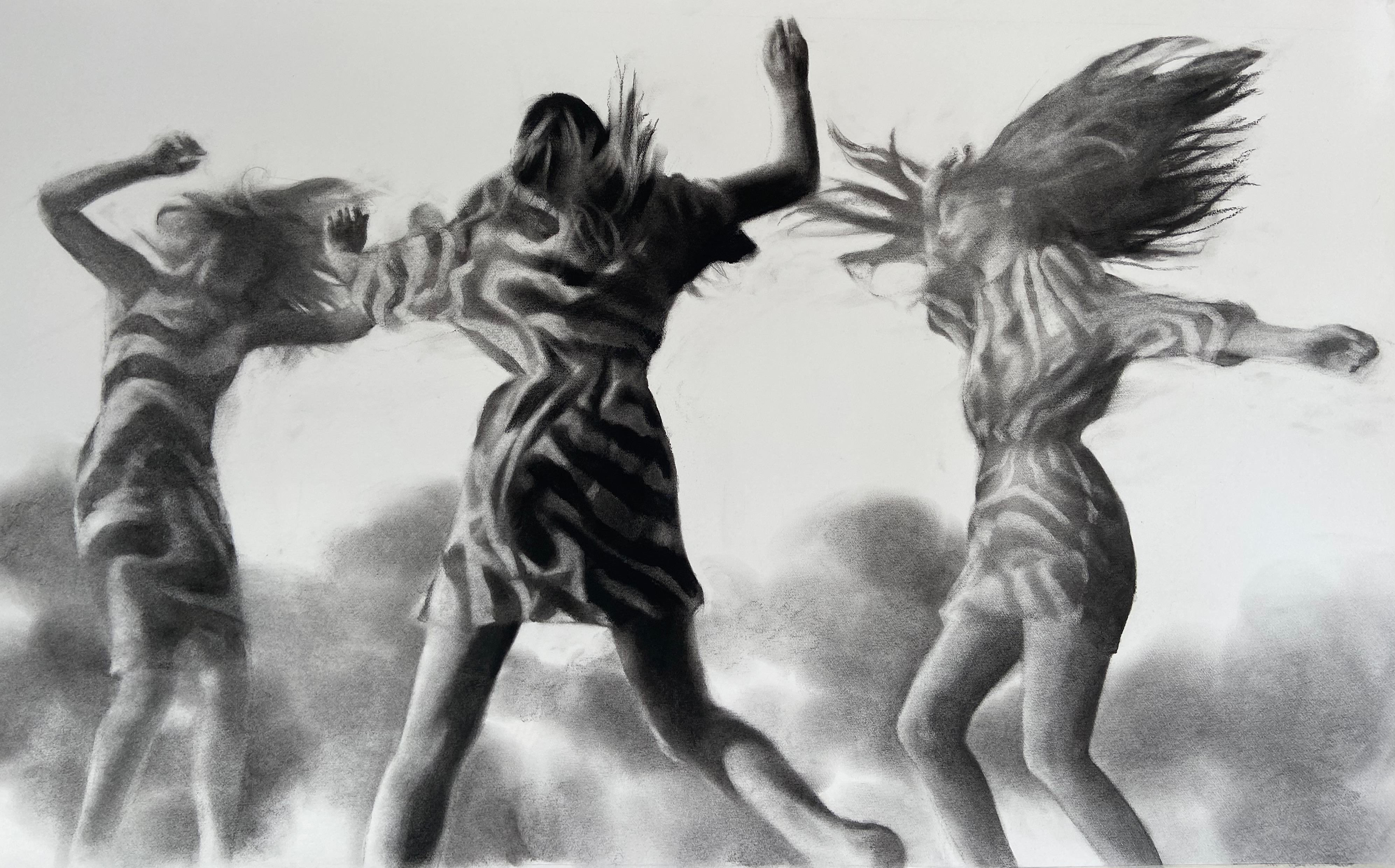Items Similar to n Memory of the Great Fire at Chicago (Cartoon for the Mural Lunette in the Chic
Want more images or videos?
Request additional images or videos from the seller
1 of 7
Edward Armitage n Memory of the Great Fire at Chicago (Cartoon for the Mural Lunette in the Chic1872
1872
About the Item
On October 8, 1871, one of the greatest fires of modern times broke out in Chicago. Engulfing the entire city within hours, it left over 90,000 people homeless and destroyed thousands of buildings, causing many people to flee into the water to escape the flames. Among the property destroyed were the proudest cultural and civic institutions of the city. While the financial center was rebuilt within a year and trade was greater in 1872 than it had been in 1870, it took over a decade for the city’s cultural resources to recover from the disaster. Many of the city’s best artists did not even return to Chicago for several years. Foreign aid poured in from around the world, with half coming from England alone. It is not surprising therefore, that in 1872 it was an English artist that should have designed the mural for City Hall commemorating the Great Fire. In his work, entitled In Memory of the Great Fire at Chicago, Edward Armitage captures in both form and text the sympathetic and supportive attitude of the people of Great Britain in the wake of this disaster.
Born in London, Edward Armitage went to Paris in 1835 to study at L’Ecole des Beaux-Arts in the prestigious atelier of Paul Delaroche (1797–1856). It was not long before Armitage became one of Delaroche’s favorite students and assisted the master in painting some of his major works. In 1842, Armitage for the first time exhibited in the Salon with his painting, Prometheus Enchained, and the very next year he felt able to return to his native England, where he competed for the decoration of the Houses of Parliament, a project which won him a substantial prize. He went on to win numerous other prizes and obtained commissions for his grand, historical schemes from both the Royal Family and for public decoration such as those in the House of Lords. From the 1840’s on, Armitage exhibited in the Royal Academy on a regular basis, gradually leaning towards more religious themes in his paintings. He was made an Associate of the Academy in 1867.
Seeing the gentle mastery of form and line that is evident in the execution of this drawing, it is no surprise that it was created and exhibited at the Royal Academy in 1872, the same year that Armitage was elected to become a Royal Academician. Armitage continued to paint murals with great success and to teach at the Royal Academy for many years, but this work, with its confident and graceful forms and its consummate draftsmanship, certainly represents the artist at the height of his career.
This drawing is accompanied by a privately published folio (18 3/4 x 26 3/4 in.) titled Selected Pictures and Drawings of Edward Armitage R.A. (1898), which includes 53 photogravures of Armitage’s paintings, including plate XLII, which was
made after the present drawing. The caption for the plate reads:
From the cartoon for the picture painted in 1872, which was bought by “The Graphic,” and presented to the City of Chicago. In the cartoon the recumbent figure is nude, in which particular it differs from the picture.
Another version of this work appears as the frontispiece in the second volume of A. T. Andreas’ History of Chicago from the Earliest Period to the Present Time in Three Volumes (1885). Volume II is subtitled Urbs Incinterata: From 1857 until the Fire of 1871. On the page facing the sepia image is the inscription,
“The original picture—a copy of which is given on the opposite page—was presented through the proprietors of the LONDON (England) GRAPHIC to the City of Chicago. After the immediate necessities of the sufferers by the fire of 1871 had been alleviated and it was announced that no more money from abroad would be needed, there remained a large sum in the hands of the proprietors of the LONDON GRAPHIC. Being unable to return the money to the donors, it was determined to use the same towards the purchase of this picture for the City of Chicago. Mr. Ed Armitage is the artist.”
The painting is titled, at the bottom of the image, Chicago and there is an indication that the work is owned by the Chicago Historical Society.
- Creator:Edward Armitage (1817 - 1896)
- Creation Year:1872
- Dimensions:Height: 41.25 in (104.78 cm)Width: 54 in (137.16 cm)Depth: 1.5 in (3.81 cm)
- Medium:
- Movement & Style:
- Period:
- Condition:
- Gallery Location:New York, NY
- Reference Number:
About the Seller
5.0
Recognized Seller
These prestigious sellers are industry leaders and represent the highest echelon for item quality and design.
Established in 1952
1stDibs seller since 2010
32 sales on 1stDibs
Typical response time: 7 hours
Associations
Art Dealers Association of America
- ShippingRetrieving quote...Ships From: New York, NY
- Return PolicyThis item cannot be returned.
More From This SellerView All
- ArmBy Frantisek KupkaLocated in New York, NYPastel on paper 13 x 19 in. (33 x 48.2 cm.) Signed (at lower right): Kupka EX COLL.: private collection, St. Louis; to Howard Baer, 1972; [Gimpel-Weitzenhoffer Galleries, New York...Category
20th Century Figurative Drawings and Watercolors
MaterialsPaper, Pastel
- Figural StudiesBy Thomas SullyLocated in New York, NYPen and ink on tan laid paperCategory
19th Century American Realist Figurative Drawings and Watercolors
MaterialsInk, Laid Paper
- "JOHN, CLIDESDALE" / "LEVATHAN AND COPPER BOTTOM" [275/276]By James Edward Deeds Jr.Located in New York, NYGraphite and crayon on ledger paper.Category
20th Century Figurative Drawings and Watercolors
MaterialsCrayon, Graphite
- "ENDIA STEAMER / "SANTAFEE. LADY" [42/43]By James Edward Deeds Jr.Located in New York, NYGraphite and crayon on ledger paper.Category
20th Century Figurative Drawings and Watercolors
MaterialsCrayon, Graphite
- "WALK, RACK" (COPPER BOTTOM) / "TALK. ABOUT. NONSINCE, BRIMMER" [277/By James Edward Deeds Jr.Located in New York, NYGraphite and crayon on ledger paper.Category
20th Century Figurative Drawings and Watercolors
MaterialsCrayon, Graphite
- "MISS. MARTIN"/ "GRAY. EAGLE" [64/65]By James Edward Deeds Jr.Located in New York, NYGraphite and crayon on ledger paper.Category
20th Century Figurative Drawings and Watercolors
MaterialsCrayon, Graphite
You May Also Like
- Jump Man, realistic figurative charcoal on paper, large size, contemporary frameBy Patsy McArthurLocated in Dallas, TXPatsy McArthur - "Jump Man", 2017 - Charcoal on Fabriano paper Paper: 127h x 150w cm / Framed: 175.5h x 201w cm "Jump Man" is a dynamic and unique charcoal on paper. McArthur captu...Category
2010s Realist Figurative Drawings and Watercolors
MaterialsArchival Paper, Charcoal
- SmokeLocated in Natchez, MSGirbent's realistic charcoal on paper drawing, "Smoke", based on a frame from the film "Breathless" by Jean Luc Godard is a portal in time. The image captures a moment in time but s...Category
2010s Realist Figurative Drawings and Watercolors
MaterialsCharcoal, Paper
- Au Louvre ILocated in Natchez, MSGirbent's realistic charcoal drawing of a woman in the Louvre is highly evocative and transmits a moodiness in shades of gray.Category
2010s Realist Figurative Drawings and Watercolors
MaterialsPaper, Charcoal
- Au Louvre IILocated in Natchez, MSGirbent's realistic charcoal drawing of a woman in the Louvre is highly evocative and transmits a moodiness in shades of gray.Category
2010s Realist Figurative Drawings and Watercolors
MaterialsPaper, Charcoal
- Feel The Beat, realistic figurative charcoal on paper of girls dancing - FramedBy Patsy McArthurLocated in Dallas, TX"Feel The Beat" is a dynamic and unique charcoal on paper. McArthur captures the movement of the female figures running in nature perfectly, and the monochromatic palette makes this ...Category
2010s Realist Figurative Drawings and Watercolors
MaterialsArchival Paper, Charcoal
- Self-PortraitBy Sean KeatingLocated in Missouri, MOSean Keating (Irish 1889-1977) "Self Portrait" c. 1950s Charcoal on Paper Signed Lower Right Framed Size: approx 20 x 16 inches A noted portrait and figure painter, influenced by both Romanticism and Realism, Sean Keating was an Irish nationalist painter who executed several iconic images of the Irish Civil war era, and of the ensuing period of industrialization. One of the great exemplars of representational painting in Ireland, Keating was an intellectual artist in that he set out to depict the birth and development of the Republic of Ireland, and his pictures are deliberately idealized even heroic. However, he held very conservative views about art - verging on the academic style - and was a committed defender of traditional Irish painting, considering much modern art to be bogus. Born in Limerick, Sean Keating studied drawing at the Limerick Technical School before winning a scholarship, arranged for him by William Orpen, to study fine art painting at the Metropolitan School of Art in Dublin. In 1914 he won the Taylor Scholarship and the following year exhibited three paintings at the Royal Hibernian Academy. Over the next period of years he spent time on the Aran Islands off County Galway, and then in London. He returned to Ireland in 1916 and painted the war of independence and the subsequent civil war. Works he completed at this time include the painting: Men of the South (1921) depicting a group of IRA men about to stage a military ambush, and An Allegory (c. 1922) which features a cluster of figures representing the fractures in the young Irish state. Meantime, in 1919, Keating was appointed an assistant teacher at the Dublin Metropolitan School of Art. Then in 1921, he staged his first one-man show at The Hall, Leinster Street. In 1923, he was elected to the Royal Hibernian Academy. In a Dublin exhibition of Irish art held in 1924, Keating was awarded the gold medal for his picture Homage to Hugh Lane - now hanging in the Hugh Lane Gallery. In the late 1920s, Keating was commissioned to record the building of the hydro-electric power generator at Ardnacrusha, near Limerick. He painted a number of paintings of this scheme. Not unlike the Soviet Realism School of painting, these paintings sought to promote the construction work as an achievement of heroic proportions. Keating's works began to attract interest abroad. He exhibited at the Royal Academy in London and, in 1930, he held a one-man show at the Hackett Gallery, New York. In 1931 Keating's one-person exhibition was staged at the Victor Waddington Galleries, Dublin. In 1934 he was made professor of the National College of Art in Dublin, and Professor of Painting, three years later. His 1937 exhibition at the Victor Waddington Galleries attracted considerable interest. In 1939, he was asked to paint a wall-painting for the Irish pavilion at the New York World Fair and duly created a huge mural of fifty-four panels. He was President of the Royal Hibernian Academy from 1949 to 1962, exhibiting nearly 300 works during the period. In 1963, a retrospective exhibition was staged at the Municipal Gallery of Modern Art, which was opened by Irish President de Valera...Category
1950s Realist Figurative Drawings and Watercolors
MaterialsArchival Paper, Charcoal





